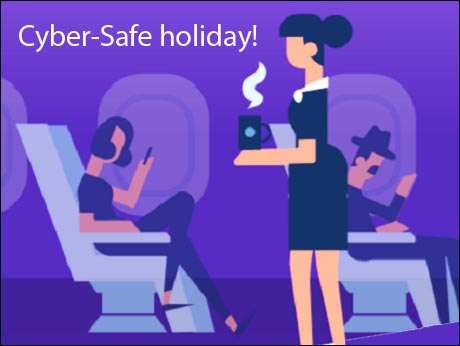
Sunil Sharma, Managing Director Sales at Sophos India & SAARC offers simple tips to stay safe while connected online, this holiday season.
September 28 2018: An estimated 5.4 million individuals travelling out of India for business and leisure spend roughly $ 600 more than the US and UK counterparts, according to a recent report in Forbes magazine. Exploring the world and visiting destinations has become the new norm for today’s connected tourists.
While we like to see beautiful locales or visit local markets to enjoy a great shopping experience the one thing that we never travel without are our gadgets. From smartphones and DSLRs to ebook readers and blue tooth speakers, gadgets play an important role in making our visits memorable.
Whatever the reason for travel – business conference or a vacation– you’ll still want to stay safe online, use connected devices and spend money on credit cards. You don’t have to “go dark” when you travel, but you do have to take extra precautions. Follow these simple security tips to protect your data and privacy without compromising on cyber security.
1. Lock Your Computer and Your Phone When You Aren’t Using Them
Set your devices to auto-lock and pick the longest and most complex unlock passcode or password you can manage. On your phone, don’t go for a four-digit PIN, going from four to eight digits means that typing in your PIN takes twice as long; but it also takes a whopping 10,000 times longer for a crook to guess. On your phone, also consider enabling “wipe device after 10 wrong guesses” if possible.
2. All That Public Wi-Fi? Don’t Count On It Being Safe
Airports and hotels all offer public Wi-Fi, but not all of them are doing security right. Security bugs are common in Wi-Fi routers, even some commercial-grade brands that are widely used in the hospitality industry. It’s better to use your cellphone network to connect instead of Wi-Fi. In many countries, it’s easy enough to buy a prepaid SIM card when you arrive, and use pay-as-you-go data as you need it. That way, you can avoid untrusted Wi-Fi networks without being stung by roaming charges when you travel abroad. And try using a VPN (Virtual Private Network) – a lot of businesses support this for creating a secure internet connection from wherever you are.
3. Turn off as Many Geo-Tagging and Geolocation Features as You Can
Apps such as Facebook, Twitter and Instagram use geo-tagging, which is where the app asks your phone for your location, and includes it in your post. Even if you have GPS turned off, your phone can still work out where you are by keeping track of all the Wi-Fi access points it can see around you. Most access points stay in one spot for years at a time, so once Facebook (or Google, or Apple, or any other service provider) knows where they are, they act as a sort of location beacon for anyone who’s nearby. So, before you post, think about whether everyone needs to know that you’re away from home.
4. Be Careful When Using Public Computers and ATMs
Public computers, like those at internet cafes or business centers at hotels, could be infected with malware, which might spy on you when you go online. One such type of malware, called a keylogger, can record everything you type on a keyboard – very useful for stealing things like passwords to your email or the login for your online bank account. Spies and cybercrooks can and do attach spy hardware to public computers. Crooks can also attach a card reader to an ATM or a sales register to skim the account numbers off your credit card.
5. Wrap Yourself in Layers of Protection
Instead of ignoring prompts to update your laptops and devices, turn on auto-updating for your computers, software and devices. If you don’t keep your devices up to date, you’ll be unprotected even against attacks that exploit already-known security holes, so you’re turning yourself into low-hanging fruit for cybercriminals. For added protection, use an anti-virus on your PCs and Macs, and think about using anti-virus on your smartphones and tablets, too. Fortify your accounts wherever possible, by using two-factor authentication – which adds another layer to the login process, such as entering a one-time code sent to your phone.